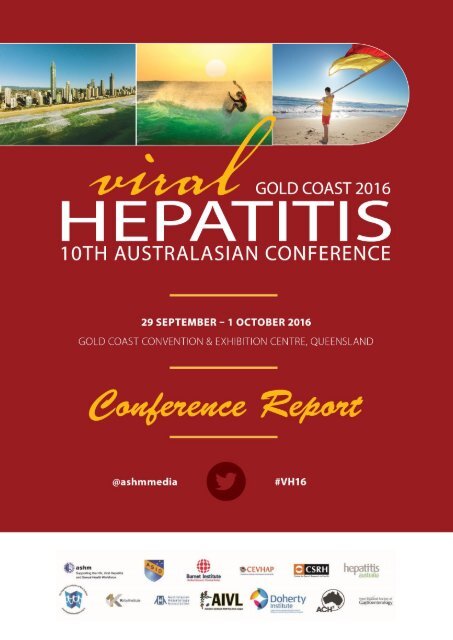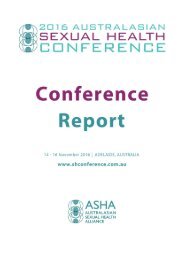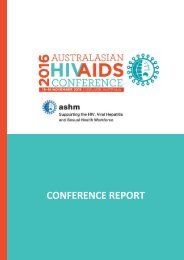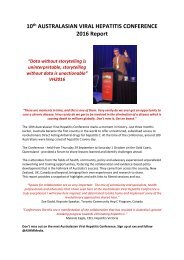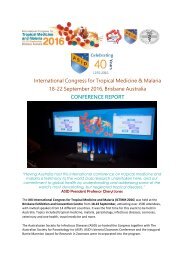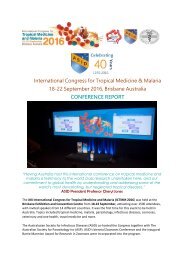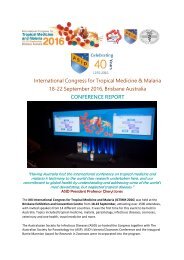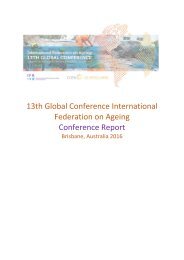ASHM_VH2016_Report_FINAL
Create successful ePaper yourself
Turn your PDF publications into a flip-book with our unique Google optimized e-Paper software.
“Data without storytelling is<br />
uninterpretable, storytelling<br />
without data is unactionable.”<br />
Dr Krispin Hajkowicz<br />
Conference Convenor<br />
10 TH AUSTRALASIAN VIRAL HEPATITIS<br />
CONFERENCE 2016 REPORT<br />
“There are moments in time, and this is one of them. Very rarely do we ever get an<br />
opportunity to cure a chronic disease. Very rarely do we get to be involved in the elimination<br />
of a disease which is causing death to millions globally. Don't miss it, get on board.”<br />
Professor Margaret Hellard, Burnet Institute<br />
The 10th Australasian Viral Hepatitis Conference marks a moment in history. Just a few months<br />
earlier, Australia became the first country in the world to offer unrestricted, subsidised access to<br />
revolutionary Direct Acting Antiviral drugs for hepatitis C. At the time of the conference, around 100<br />
Australians were being cured of hepatitis C every day.<br />
The Conference - held from Thursday 29 September to Saturday 1 October on the Gold Coast,<br />
Queensland - provided a forum to share lessons learned and identify challenges ahead.<br />
The 444 attendees from the fields of health, community, policy and advocacy experienced unparalleled<br />
networking and training opportunities, fostering the collaboration and evidence-based policy<br />
development that is the hallmark of Australia’s success. They came from across Australia, New<br />
Zealand, Europe, Asia, the Americas and beyond, bringing their own experiences and research to share.<br />
This report provides a snapshot of highlights, with links to speaker presentations, abstracts, audio<br />
recordings and video.<br />
“Conferences like this are a manifestation of the collaboration that has resulted in<br />
Australia's ground breaking progress towards eliminating hepatitis C.”<br />
Melanie Eagle, CEO, Hepatitis Victoria<br />
1
Contents<br />
Take Home Messages 3<br />
The Data: Surveillance <strong>Report</strong>s 2016 4<br />
In Focus - HCV Better Services 6<br />
Prescribing in Primary Care 6<br />
Enhancing Diagnosis and Linkage to Care 7<br />
In Focus - HBV 13<br />
HIGHLIGHTS 16<br />
Keynote Speakers 16<br />
Associated Events 18<br />
Towards Elimination 19<br />
SPOTLIGHT - Engagement 20<br />
Australasian Viral Hepatitis Elimination Conference 2017 21<br />
With Thanks 22<br />
“Spaces for collaboration are so very important. The mix of community and<br />
specialists, health professionals and advocates that I have seen here at the<br />
Australasian Viral Hepatitis Conference is truly exceptional. I will leave here<br />
inspired, and determined to take home and implement some of the<br />
revolutionary approaches shared here.”<br />
Zoe Dodd, Keynote Speaker, Toronto Community Hep C Program, Canada<br />
Don't miss out on the 2017 Australasian Viral Hepatitis Elimination Conference.<br />
Find out more at www.avhec.com.au or follow @<strong>ASHM</strong>media on twitter.<br />
2
Take Home Messages<br />
“We have been given the enormous good fortune of having access to these new hepatitis C<br />
medications. We are the only country in the world offering them to everyone without<br />
restriction. We must use them well, and we must use them wisely.”<br />
Professor Margaret Hellard, Burnet Institute<br />
Media Release: 100 Hundred Australians Cured Of Hepatitis C Every Day<br />
Calls for increased health worker education and outreach to meet viral hepatitis elimination goals<br />
Australia is making great progress towards eliminating hepatitis C, with record numbers now being<br />
cured of the disease. The challenge now is how to effectively engage diverse populations in both<br />
prevention and treatment programs, and to overcome barriers in the health system preventing<br />
many people living with both hepatitis C and hepatitis B from coming forward for testing and<br />
treatment. Read the 2016 Australasian Viral Hepatitis Conference media release.<br />
SNAPSHOT: KEY MESSAGES FROM VH16<br />
• We need a diversity of models of care to reach diverse populations. One size does NOT fit all.<br />
• Stigma is killing people. Stigma and discrimination by the health work force is one of the most<br />
profound barriers to care for people with viral hepatitis.<br />
• Engaging marginalised and “difficult-to-engage” populations is key.<br />
HCV<br />
• The explosive uptake of HCV treatment will not be maintained.<br />
• Expect to see reinfections. Make sure those who are reinfected aren’t stigmatised.<br />
• Be prepared for viral resistance.<br />
• HCV antibody testing is high in Australia, but there still exists a large undiagnosed HCV RNA pool<br />
and people are not linked to care.<br />
• Enhanced screening is required in addition to new diagnostic tools such as Point of Care tests.<br />
Successful components of interventions/models to enhance HCV testing/care need to be<br />
disseminated, shared and translated.<br />
• The future of upscaling lies in the community.<br />
• Challenges: Cost of drugs, war on drugs, remote and rural communities, mental health,<br />
co morbidities, poverty.<br />
MJA OPED LEVINIA CROOKS<br />
Health workforce discrimination undermines hepatitis C success<br />
Australia is currently enjoying international acclaim for its revolutionary<br />
response to hepatitis C. Yet despite this success, stigma and discrimination<br />
by the health workforce threaten to prevent us from optimising these<br />
achievements. Read the Oped by <strong>ASHM</strong> CEO Levinia Crooks.<br />
3
The Data: Surveillance <strong>Report</strong>s 2016<br />
VH 2016 delegates were the first to receive the latest national viral hepatitis statistics for Australia<br />
with the launch of The Kirby Institute’s Hepatitis B and C in Australia Annual Surveillance <strong>Report</strong><br />
Supplement and the UNSW Centre for Social Research in Health’s Annual <strong>Report</strong> of Trends in<br />
Behaviour Supplement 2016 on Viral Hepatitis.<br />
KIRBY SURVEILLANCE REPORT – FINDINGS FROM 2015<br />
• 232 600 with HBV yet only 62% of those diagnosed and only 6% had received treatment.<br />
• 227 306 with HCV, with 82% diagnosed and 22% having received anti-viral treatment.<br />
• HCV rates in Aboriginal and Torres Strait Islander population are 4 times greater than<br />
non-Indigenous population and have increased by 43% in the five past years.<br />
HBV rates were 3 times higher.<br />
• The number of people with liver cirrhosis has doubled in a decade.<br />
HCV<br />
• Close to 30 000 people were cured of HCV in the first 3 months after subsidised DAAs were<br />
introduced in March 2016 – approximately 100 per day. Uptake has been particularly high in<br />
people with advanced liver disease.<br />
• However, the vast majority of people with HCV remain at increased risk of serious liver disease<br />
without treatment.<br />
Priorities for HCV<br />
• Increased diagnosis<br />
• Expanded treatment coverage<br />
• Prevention strategy scale up e.g. NSP that also reaches Aboriginal and Torres Strait Islander<br />
populations<br />
Priorities for HBV<br />
• Scale up of diagnosis and treatment<br />
• Enhanced culturally specific strategies<br />
• Priority populations: People from Asia and the Pacific, Aboriginal and Torres Strait Islander<br />
peoples, MSM engaged in high risk sexual activity, PWID.<br />
CSRH TRENDS IN BEHAVIOUR REPORT<br />
• A mistrust of the health system and ongoing stigma from health workers against injecting drug<br />
users are two significant barriers to HCV treatment.<br />
• Only 35% of gay and bisexual men are aware of the existence of an HCV cure.<br />
• HIV status influenced their knowledge and attitudes.<br />
• Suggests HCV education + prevention for gay men should be tailored according to HIV status<br />
• HBV management in primary care would be improved through greater community-based<br />
outreach programs and education programs for health professionals.<br />
4
IN THE NEWS<br />
Read Systemic barriers, stigma and discrimination preventing people living with viral hepatitis or HIV<br />
accessing care in the onthewards.org blog.<br />
5
In Focus – HCV Better Services<br />
PRESCRIBING IN PRIMARY CARE<br />
“All clinicians with the skills and experience to manage HCV should be able to initiate treatment”<br />
Read <strong>ASHM</strong>’s Position Statement of Hepatitis C Prescribing.<br />
Key points re Primary Care<br />
• Clinicians should be able to initiate treatment across the range of primary care settings:<br />
Aboriginal Medical Services, Drug and Alcohol Services, Sexual Health Services, youth, migrant,<br />
women's or men's health services, mental health services or corrections/juvenile justice services.<br />
• Patients without advanced or complicated disease can be managed in primary care.<br />
• All GPs need ongoing education in order to diagnose and treat or refer.<br />
• Additional training and support is required for experienced and trained GPs to prescribe<br />
independently.<br />
• There is significant scope for nurse-led care.<br />
• Main barriers include education and access to FibroSCAN. A Victorian study by the Burnet<br />
Institute and Monash University found most GPs were interested in prescribing DAAS but half<br />
were unsure if active IDU were eligible for treatment and only 10% had access to FibroSCAN.<br />
Read the abstract or view the slides from Dr Amanda Wade’s presentation.<br />
• Related study: Curing Hepatitis C in General Practice: The First 60 Days - Read the abstract or<br />
view the slides by Dr David Baker.<br />
• Note: both presentations are available for viewing as video on Conference Connect TV.<br />
Training was run from the conference for primary care medical practitioners to prescribe new DAA<br />
treatments. For more information about courses and resources visit www.ashm.org.au.<br />
6
ENHANCING DIAGNOSIS AND LINKAGE TO CARE<br />
No one left behind<br />
How do we reach and link to care the estimated 63 000 undiagnosed Australians with HCV?<br />
“We have to understand that people requiring treatments are not going to come to the<br />
tertiary hospitals, they're not going to come to us. We need to think about how we provide<br />
treatment and care in the places that are acceptable and accessible to those who are at<br />
most risk, to the people who are most affected.”<br />
Image: Key review of HBV and HCV interventions to enhance testing, care linkage and treatment.<br />
7
PRIORITY POPULATION: PWID<br />
From the Hepatitis B and C in Australia Annual<br />
Surveillance <strong>Report</strong> Supplement<br />
• 57% of PWID attending NSP have HCV<br />
• Among PWID w prior exposure to HCV, 12%<br />
reported ever receiving HCV treatment and 2%<br />
had received treatment in the last 12 months.<br />
• 16% of PWID reported sharing needles and<br />
syringes in the last year.<br />
• The majority of new infections are attributed to<br />
injecting drug use.<br />
Key findings<br />
• Discrimination from health workers lessens the likelihood of PWID engaging in future treatment.<br />
• Many PWID have received highly stigmatised care and remain alienated from health services.<br />
• Peer support plays a valuable role in HCV treatment access in OST settings.<br />
• Peer services should be offered to all PWID with HCV.<br />
• People with the “lived experience” should be involved in development of care.<br />
Case Study: Lessons from a community-based, client-driven program in Canada – Keynote Speaker<br />
Zoe Dodd<br />
• Future of HCV treatment lies in primary care<br />
• Multiple services in one place worked extremely well for this project, with community garden,<br />
NSP, HCV treatment, health centre all located together.<br />
• Word of mouth important promotion tool - accounted for 1/3 of new clients.<br />
• PWID are not homogenous: different people have different needs and different levels of support<br />
are required.<br />
• Stigma is alienating PWID from health facilities and excluding them from care.<br />
• It’s not just about HCV, or drugs. There are bigger things at play that need to be understood e.g.<br />
poverty, exclusion.<br />
• Watch the video of Zoe Dodd’s presentation on Conference Connect TV.<br />
Case Study: Recruitment and Follow-up of PWID into a Nurse-Led HCV Treatment Trial<br />
A flexible, nurse-led model of care may help overcome some of the barriers associated with<br />
engaging PWID in care and treatment. Since HCV transmission is driven by PWID who are frequently<br />
not engaged in care, nurse-led care may be important in eliminating HCV transmission.<br />
Read the abstract or view the slides of this study presented by Dr Joseph Doyle, Co-Head, Hepatitis<br />
Research, Burnet Institute, Australia.<br />
Case Study: Quinh Treatment Management Program<br />
• In 2014, QuIHN set up a Treatment Management Program which includes the Treatment in<br />
Injecting Drug Environment (TIDE) Project.<br />
• Two-way communication system developed with tertiary settings for the most appropriate,<br />
timely treatment access for clients, a suite of screening and assessment procedures for<br />
community based prescribing, and an opportunity to increase testing and treatment options for<br />
clients who may not access current treatment facilities.<br />
8
• Key learnings: need for flexibility,<br />
creativity, collaboration and<br />
spontaneity, whilst supporting<br />
the client through treatment as<br />
the centre focus of the project.<br />
• Read the abstract and view the<br />
slides presented by Nik<br />
Alexander, Senior Program<br />
Manager - Harm Reduction<br />
Services, Queensland Injectors<br />
Health Network (QuIHN).<br />
• Watch the video of Zoe Dodd’s<br />
presentation on Conference<br />
Connect TV.<br />
Case Study: The LiveRLife Campaign - Associate Professor Jason Grebely, The Kirby Institute<br />
Liver disease burden among people who inject drugs (PWID) is high, yet few strategies to enhance<br />
liver disease screening have been evaluated. The aim of this study was to assess factors associated<br />
with severe fibrosis/cirrhosis and follow-up among PWID participating in a liver health promotion<br />
campaign.<br />
Conclusions<br />
• Demonstrated considerable liver disease burden in this population<br />
• A high proportion attended post-LiveRLife clinical follow-up<br />
• Provided an opportunity to address other health issues (e.g. HAV/HBV vaccinations)<br />
• Developed key partnerships between services, clinical providers, and researchers<br />
• Demonstrated the feasibility of interventions to enhance health outcomes among people in drug<br />
and alcohol settings.<br />
• View the slides.<br />
• Watch Jason Grebely’s presentation on Conference Connect TV.<br />
9
PRIORITY POPULATION: ABORIGINAL AND TORRES STRAIT<br />
ISLANDER PEOPLE<br />
Presentation: HCV Prevalence among Aboriginal and Torres Strait Islander Australians: A Meta<br />
Analysis - Dr Mary Ellen Harrod, Chief Executive Officer, NSW Users and AIDS Association<br />
• HCV rates in Aboriginal and Torres Strait Islander population are 4 times greater than<br />
non-Indigenous population and have increased by 43% in the five past years.<br />
• 70% of Aboriginal and Torres Strait Islander PWID in an NSP program had HCV.<br />
• Despite higher notifications, only four of the eight jurisdictions of Australia are included in anti-<br />
HCV reporting.<br />
• Highest anti-HCV prevalence is in Aboriginal people who inject drugs followed by Aboriginal<br />
people in prison.<br />
Presentation: Experiences of Diagnosis, Care and Treatment among Aboriginal people with HCV -<br />
Loren Brener, Senior Research Fellow, Centre for Social Research in Health<br />
• This CSRH study of 203 Aboriginal people living with HCV confirmed the importance of providing<br />
a HCV diagnosis in a culturally appropriate way.<br />
• View the presentation slides and listen to the audio recording.<br />
Case Study: Deadly Liver Mob - Kerri-Anne Smith, Aboriginal Hepatitis C Health Promotion Officer<br />
Deadly Liver Mob Project (DLMP) operates out of the Needle and Syringe Program (NSP) in<br />
partnership with the co-located Sexual Health Clinic Mt Druitt Community Health Centre, New South<br />
Wales. It is dedicated to improving Aboriginal and Torres Strait Islander peoples access into hepatitis<br />
C treatment and aims to create a more meaningful encounter with clients accessing the NSP as well<br />
as their family, community and injecting network.<br />
• Storytelling approach used.<br />
• Aboriginal staff front and centre.<br />
• Further incentive offered to encourage participants to go into Sexual Health Clinic for hepatitis<br />
testing, hep B vaccinations and /or sexual health screening.<br />
• NSP and sexual health services co located. DAAs could be rolled in to this.<br />
• Note: Different priorities across SH, NSP and community leadership need to be acknowledged.<br />
e.g. you might not want to screen a 91 yr old for STIs, but engaging him/her could be vital to<br />
engaging the community.<br />
• Find out more on HealthInfoNet or watch the presentation on Conference Connect TV.<br />
PRIORITY POPULATIONS: REMOTE/RURAL<br />
Presentation: Community Assessment of Fibrosis in Primary Care and Rural Settings<br />
- Annie Balcomb, General Practitioner, Prince St Medical Practice<br />
Challenges of rural care setting include:<br />
• Limited Fibroscan and imaging access<br />
• Travel distances and poor public transport<br />
• Specialist and investigation costs - few public gastroenterology clinics<br />
• Lack of gastroenterologists and long waiting lists >6 mths<br />
• Stigma living with HCV<br />
• Shortage/high turnover of GP’s in some settings<br />
10
Rural advantages include:<br />
• Specialists known and readily available for advice<br />
• Clients well known and trust GP’s<br />
• Outreach Fibroscan clinics<br />
• Used to dealing with complex chronic conditions<br />
• Keen to upskill and take on challenges<br />
• View the presentation, which provides guidance on diagnosing advanced liver disease/cirrhosis.<br />
PRIORITY POPULATION: PRISONS<br />
• Prisoners have been identified in the Third National Hepatitis C Strategy 2010–2013 as a priority<br />
population for assessment and treatment.<br />
• Around 30,000 individuals are in Australian prisons at any one time with around one fifth testing<br />
positive for hepatitis C antibodies.<br />
• Incidence is associated with older age, injecting methamphetamine and injecting heroin, with no<br />
protective effect of OST.<br />
• Despite this high prevalence, treatment coverage is low.<br />
• Australian prisons are the responsibility of individual state and territory governments and key<br />
evidence-based strategies remain controversial to some.<br />
• There is no formal NSP yet modelling suggests this would have the greatest impact on HCV.<br />
• In 2015, a Parliamentary Inquiry into Hepatitis C in Australia highlighted the need to establish a<br />
framework for a national approach to BBVs in prisons.<br />
• Conclusion: Australia’s response to BBVs in prisons has been slow, disjointed and in most cases<br />
does not address BBVs through effective strategies.<br />
• View the slides and audio recording from Kevin Marriott’s presentation.<br />
• SToP-C - is the first treatment-as-prevention study for HCV worldwide and will establish this<br />
intervention in public health policy internationally.<br />
Priorities<br />
• Improved harm reduction strategies<br />
• Evaluation of interferon-free HCV treatment as prevention strategies in prisons<br />
Related Studies<br />
Stable Incidence of Hepatitis C Virus Infection among People with a History of Injecting Drug Use in<br />
an Australian Prison Setting, 2005-2014: The HITS-P Study - by Evan Cunningham, PhD Candidate,<br />
Kirby Institute<br />
• Syringe sharing was associated with HCV infection among continually imprisoned participants,<br />
irrespective of frequency of injecting or the type of drug injected.<br />
• Each individual injecting event carries with it a higher chance of HCV infection due to the scarcity<br />
of clean injecting equipment.<br />
• Even people with a lower frequency of injecting drug use in the prison environment have a high<br />
risk of infection.<br />
• View the slides.<br />
• Watch on Conference Connect TV.<br />
11
The Prison Economy of Needles and Syringes: What Opportunities Exist for BBV Risk Reduction<br />
When Prices are so High? - Carla Treloar, Professor, Centre for Social Research in Health, UNSW<br />
• View the presentation slides and listen to the audio recording.<br />
• Watch on Conference Connect TV.<br />
Hepatitis C Virus Exposure, Infection and Associated Risk Behaviours in Two Maximum-Security<br />
Prisons in New South Wales, Australia - Behzad Hajari, Associate Lecturer, UNSW<br />
Among prisoners at risk of HCV, those with previous HCV exposure and clearance were more likely to<br />
report high risk injecting than those with no previous exposure, suggesting the risk for re-infection<br />
and the need for increased prevention activities. (SToP-C Study)<br />
• Watch on Conference Connect TV.<br />
12
In Focus – HBV<br />
• 232 600 with HBV in Australia in 2015<br />
• 38% were born in Asia Pacific / 9.3% were Aboriginal and Torres Strait Islander people<br />
• Rates in Indigenous Australians are 3 times higher than non-Indigenous Australians.<br />
• 38% of people with HBV remain undiagnosed.<br />
• 15% would benefit from treatment but only 6% have received it.<br />
• An estimated 21, 239 people are currently not receiving the treatment they need.<br />
• Rates of notification have declined thanks to infant and adolescent vaccination programs.<br />
• There is limited information on uptake of testing.<br />
• In the Northern Territory, HBV prevalence is 3.4%.<br />
In NSW<br />
• 77 000 people with HBV but only half are diagnosed.<br />
• Approximately 60% were born overseas.<br />
LAUNCH OF 3RD HEPATITIS B MAPPING PROJECT<br />
What’s new?<br />
• Updated estimates of prevalence, diagnosis, treatment and monitoring for 2015.<br />
• Data reported for each newly generated Primary Health Network.<br />
• Information of treatment provider type and drug prescribing patterns.<br />
• Measurement of trends over time according to Primary Health Network.<br />
13
Key findings<br />
• Treatment uptake increased 16% nationally in 2013-2014, most significantly in NSW.<br />
• No PHNs reached the target of 15% treatment uptake.<br />
• 15% engaged in care.<br />
• View the presentation slides by Benjamin Cowie or to download, see previous reports and<br />
additional information visit the <strong>ASHM</strong> website.<br />
• View/hear Benjamin Cowie’s presentation Hepatitis B vaccination in the era of elimination.<br />
• Watch the launch of the Third National Hepatitis B Mapping <strong>Report</strong> on Conference Connect TV.<br />
CASCADE OF CARE<br />
Barriers to testing and treatment:<br />
• Poor awareness in both health workers and patients.<br />
• GP education essential.<br />
• Perception (unproven) that there's too much testing for HBV going on.<br />
• Translating a brochure into a language someone speaks isn't sufficient.<br />
• People’s primary source of HBV information is their GP. If the GP doesn't promote testing or<br />
initiate a conversation then person likely to fall through the gap.<br />
Presentation: The Cascade of Care for Chronic Hepatitis B in Australia, 2013-2014<br />
- Jennifer MacLachlan, WHO Collaborating Centre for Viral Hepatitis, the Doherty Institute<br />
• The largest gap in the cascade of care is between diagnosis and engagement in ongoing care<br />
Treatment uptake is increasing more rapidly than other indicators<br />
• Large gap between current levels and National Strategy targets<br />
• Further work<br />
o Improving data sources and estimates<br />
o Linkage of data to identify individual trajectories of care, validate assumptions<br />
o Continuing to measure progress, impact of initiatives and policy changes<br />
• View the presentation slides<br />
• Watch on Conference Connect TV<br />
Presentation: Interventions to enhance the hepatitis B cascade of care - Jennifer MacLachlan,<br />
WHO Collaborating Centre for Viral Hepatitis, the Doherty Institute<br />
• Major gaps in cascade are in diagnosis and engagement in care.<br />
• Further information needed on those lost to engagement in care, successful interventions.<br />
• Key aspects include prior assessment of needs, systematic processes, tailoring to affected<br />
communities.<br />
• Watch on Conference Connect TV<br />
Presentation: HBV Treatment: Past, Present, Future - Scott Bowden, Senior Medical Scientist,<br />
Victorian Infectious Diseases Reference Laboratory<br />
• View the presentations slides.<br />
14
IN THE COMMUNITY<br />
Case Study: Two hepatitis B outreach testing models - Marina Suarez Multicultural HIV and<br />
Hepatitis Service MHAHS<br />
• Indonesian community targeted through community planning project.<br />
• Chinese community targeted through private English-language college.<br />
• Both models equally successful.<br />
• Conclusion: No one size fits all. Outreach models need to be adapted to community, settings and<br />
resources available.<br />
• View/hear Marina Suarez’ presentation Engaging Diverse Communities in the Response to<br />
Hepatitis B: The Hepatitis B Community Alliance NSW<br />
• Watch on Conference Connect TV<br />
Case study: Linh Nguyen<br />
Personal story of Linh, a Vietnamese mother of 2, one of whom is living with Hepatitis B<br />
• Adult diagnosis of HBV in Australia.<br />
• Provided with very limited information that was inaccessible to her: technical language she<br />
couldn’t comprehend and pamphlets she couldn’t understand.<br />
• Was offered no support at time.<br />
• Profound stigma and discrimination from her own community.<br />
• Enormous guilt at passing HBV to her child.<br />
• Strong call for doctors to appreciate how overwhelming this can be for patients, the cultural and<br />
social elements involved, the fear they might have every time they come for an appointment,<br />
and how this may impact their ability to assimilate information.<br />
• Watch on Conference Connect TV<br />
15
Highlight – Keynote Speakers<br />
Watch video recordings of our keynote speakers and other presentations from VH16:<br />
Conference Connect<br />
Dr Andrew Hill<br />
Senior Visiting Research Fellow Pharmacology<br />
and Therapeutics, University of Liverpool, UK<br />
Treating epidemics with low cost<br />
medications<br />
If pharmaceutical companies refuse to lower<br />
prices, we need back-up mechanisms to<br />
ensure access:<br />
• Compulsory licenses<br />
• Buyers’ Clubs<br />
Enaam Oudih<br />
Manager, BBV programs, Practice Managaer,<br />
Multicultural Services<br />
Cross Cultural Community Engagement<br />
Matters<br />
Work must be:<br />
• Directed at individual and social<br />
environments<br />
• Participatory and transformative<br />
From individual to family/group to<br />
community back to individual<br />
Kate Seear<br />
ARC DECRA Fellow and Senior Lecturer in Law,<br />
Monash University, Victoria, Australia<br />
Hepatitis transmission and prevention<br />
Although they might not always view it as<br />
part of their job, lawyers have ethical and<br />
professional obligations to consider the<br />
potential for their work to shape, reinforce<br />
and entrench stigma, to produce harms and<br />
to shape BBV epidemics.<br />
• View the presentation slides.<br />
Alex Plos<br />
PhD, Assistant Professor, Princeton University,<br />
USA<br />
Deciphering Host Range Restrictions of<br />
Human Hepatitis Viruses<br />
A focus on the construction of animal models<br />
suitable for studying human hepatitis virus<br />
infections at the organismal levels as well as<br />
for preclinical testing of novel intervention<br />
approaches.<br />
16
Alex Thompson<br />
Director of Gastroenterology, St Vincent's<br />
Hospital<br />
Recommendations for the Management of<br />
Hepatitis C Virus Infection: Australian and<br />
International Guide<br />
Greg Dore<br />
Head, Kirby Institute, UNSW<br />
The New HCV Treatment Era in Australia:<br />
Early Lessons<br />
• View/listen to the presentation slides.<br />
Zoe Dodd<br />
Co-founder and Program Coordinator,<br />
Toronto Community Hep C Program, Toronto,<br />
Canada<br />
The Future of Hep C Care for People Who Use<br />
Drugs: Lessons from a Community-Based,<br />
Harm Reduction, Client-Driven Program in<br />
Toronto, Canada<br />
• View the presentation slides.<br />
Peter Revill<br />
Senior Medical Scientist, Victorian Infectious<br />
Diseases Reference Laboratory (VIDRL),<br />
Doherty Institute, Victoria, Australia<br />
Global Strategies are Required to Cure and<br />
Eliminate HBV<br />
Differences in the HBV and HCV lifecycles<br />
mean that curative approaches for HCV will<br />
not cure HBV infection. There are a number of<br />
major challenges that must be overcome<br />
before HBV cure can be realised.<br />
• View/listen to the presentation slides.<br />
17
Highlight – Associated Events<br />
BMS Breakfast Satellite Meeting<br />
• HCV Elimination by 2026: Australia leads the world<br />
• Dr Norman Swan led a panel of national experts in a Q&A style discussion to determine how<br />
Australia will lead the world in the elimination of HCV. Attended by 176 delegates.<br />
Abbvie Breakfast<br />
Satellite Meeting<br />
• Curing HCV - Leave<br />
No Patient Behind<br />
• Whilst the new all-oral<br />
direct acting antivirals<br />
have revolutionised the<br />
treatment of hepatitis C<br />
in Australia, challenges<br />
exist with certain<br />
patient types and nontraditional<br />
treatment<br />
settings. The<br />
Symposium addressed<br />
these challenges<br />
through real world case<br />
studies. Attended by<br />
143 delegates.<br />
Curing Hepatitis C with new treatments course for GPs and other medical professionals.<br />
This course covered the patient and prescriber eligibility for the new interferon-free treatment<br />
regimens listed on the PBS S85 (General Schedule) from 1 March 2016. Completion of this course<br />
assists primary care medical practitioners to confidently prescribe these new hepatitis C treatment<br />
regimens in consultation with a specialist.<br />
<strong>ASHM</strong> Highlight:<br />
• Viral Hepatitis 101 Workshop<br />
• Workshop for non-clinical professionals working in the sector.<br />
Introduction to the Nursing Care and Management of Patients with Advanced Liver Disease<br />
• The AHA aims to educate registered nurses across primary and tertiary care about the specialised<br />
management of patients with cirrhosis of the liver.<br />
18
Spotlight – Towards Elimination<br />
NEW PARTNERSHIP<br />
AIMS TO ELIMINATE<br />
HEPATITIS C IN A<br />
DECADE<br />
The quest to eliminate the burden<br />
of hepatitis C in Australia within a<br />
decade was boosted by a new,<br />
exciting collaborative project<br />
between Burnet Institute and The<br />
Kirby Institute, formally launched<br />
at the Australasian Viral Hepatitis<br />
Conference.<br />
Known as the ‘Australian Hepatitis<br />
C Elimination Program’ the event<br />
was welcomed by delegates with<br />
t-shirts featuring a specially<br />
designed Reg Mombassa t-shirt.<br />
The event was accompanied by a<br />
twitter campaign that involved<br />
high profile individuals such as<br />
Tanya Plibersek, and a new video<br />
in the Change Project hepatitis C<br />
series. Find out more about<br />
‘Elimination is the goal’.<br />
19
Spotlight – Engagement<br />
20
Don’t miss out on 2017!<br />
Australasian Viral Hepatitis Elimination<br />
Conference 2017<br />
10 – 11 August 2017, Pullman Cairns International, Cairns, Queensland<br />
There is an urgent need to increase the number of clinicians able to treat hepatitis B and hepatitis C.<br />
Until March 2016, therapy uptake for HCV was slow, due to both hard to reach priority populations<br />
and the difficulty and length of the treatment itself. In hepatitis B, many people remain undiagnosed<br />
and confusion still exists around the idea of a ‘healthy carrier’, masking the need for monitoring and,<br />
in some cases, the prescription of effective therapy.<br />
This is the first time that the Australasian Viral Hepatitis Elimination Conference will be held. It is to<br />
be held in the off-year of the Australasian Viral Hepatitis Conference to cater for the educational<br />
needs of those working in the viral hepatitis sector.<br />
The Committee look forward to welcoming you to Cairns in 2017<br />
Find out more at www.avhec.com.au or follow @<strong>ASHM</strong>media on twitter.<br />
21
With thanks<br />
Conference organising committee<br />
Tanya Applegate<br />
Scott Bowden<br />
Ben Cowie<br />
Krispin Hajkowicz<br />
Greg Dore<br />
Jeffrey Wong<br />
Kelly Barclay<br />
Angella Duvnjak<br />
Joanne Morgan<br />
Mark Stoove<br />
Emma Day<br />
Carla Treloar<br />
Helen Tyrrell<br />
The Australian Centre for HIV and Hepatitis Virology Research (ACH2)<br />
Victorian Infectious Diseases Reference Laboratory/Doherty Institute<br />
<strong>ASHM</strong> Viral Hepatitis & The Coalition for the Eradication of Viral Hepatitis<br />
in Asia Pacific (CEVHAP)<br />
Australasian Society for Infectious Diseases (VH-SIG)<br />
The Kirby Institute<br />
New Zealand Society of Gastroenterology<br />
Hepatitis Foundation of New Zealand<br />
Australian Injecting & Illicit Drug Users League (AIVL)<br />
Australian Hepatology Association<br />
Burnet Institute<br />
<strong>ASHM</strong> NPED<br />
Centre for Social Research in Health (CSRH)<br />
Hepatitis Australia<br />
Basic Science Committee<br />
Scott Bowden<br />
Tanya Applegate<br />
Karla Helbig<br />
Heidi Drummer<br />
Mark Douglas<br />
Silvana Gaudieri<br />
Nick Eyre<br />
Nicole Robertson<br />
Victorian Infectious Diseases Reference Laboratory (VIDRL)<br />
Australian Centre for HIV and Hepatitis Virology Research (ACH2) /<br />
Kirby Institute<br />
Adelaide University<br />
The Burnet Institute<br />
University of Sydney<br />
University of WA<br />
Adelaide University<br />
<strong>ASHM</strong> Representative<br />
Clinical Care Committee<br />
Krispin Hajkowicz<br />
Joanne Morgan<br />
Greg Dore<br />
Jeffrey Wong<br />
Stephen Pianko<br />
Paul Clark<br />
Olivia Cullen<br />
Graeme Macdonald<br />
Sonja Hill<br />
ASID - Australasian Society for Infectious Diseases<br />
AHA<br />
Kirby Institute<br />
New Zealand Society of Gastroenterology<br />
GESA/ALA<br />
Local QLD Gastroenterologist and ALA member<br />
Local QLD Gastroenterologist and ALA member<br />
Qld Hepatologist and Liver Transplant Physician<br />
<strong>ASHM</strong> NPED Representative<br />
22
Community & Social Research Committee<br />
Helen Tyrrell<br />
Carla Treloar<br />
Angella Duvnjak<br />
Kathryn Leafe<br />
Jack Wallace<br />
Elena Cama<br />
Kristen Stone<br />
Ursula Swan<br />
Jodie Walton<br />
Suzanne Fraser<br />
Nik Alexander<br />
Jenny Kelsall<br />
Beni Falemaka<br />
Hepatitis Australia<br />
Centre for Social Research in Health<br />
Australian Injecting and Illicit Drug Users League<br />
NZ Needle Exchange Program<br />
Australian Research Centre in Sex, Health and Society<br />
Centre for Social Research in Health<br />
Cancer Council NSW<br />
Mental Health Commission WA & Hepatitis WA<br />
Hepatitis Queensland<br />
National Drug Research Institute<br />
QUIHN, Queensland<br />
Harm Reduction Victoria<br />
<strong>ASHM</strong> NPED representative<br />
Epidemiology, Public Health & Prevention<br />
Ben Cowie<br />
Lisa Maher<br />
Emma Day<br />
Kelly Barclay<br />
Mark Stoove<br />
Jennifer MacLachlan<br />
Jason Grebely<br />
<strong>ASHM</strong> / Doherty Institute<br />
The Kirby Institute<br />
<strong>ASHM</strong> – Viral Hepatitis Program<br />
Hepatitis Foundation of New Zealand<br />
The Burnet Institute<br />
Victorian Infectious Diseases Reference Laboratory (VIDRL)<br />
The Kirby Institute<br />
Conference Collaborators<br />
Conference Sponsors<br />
23


